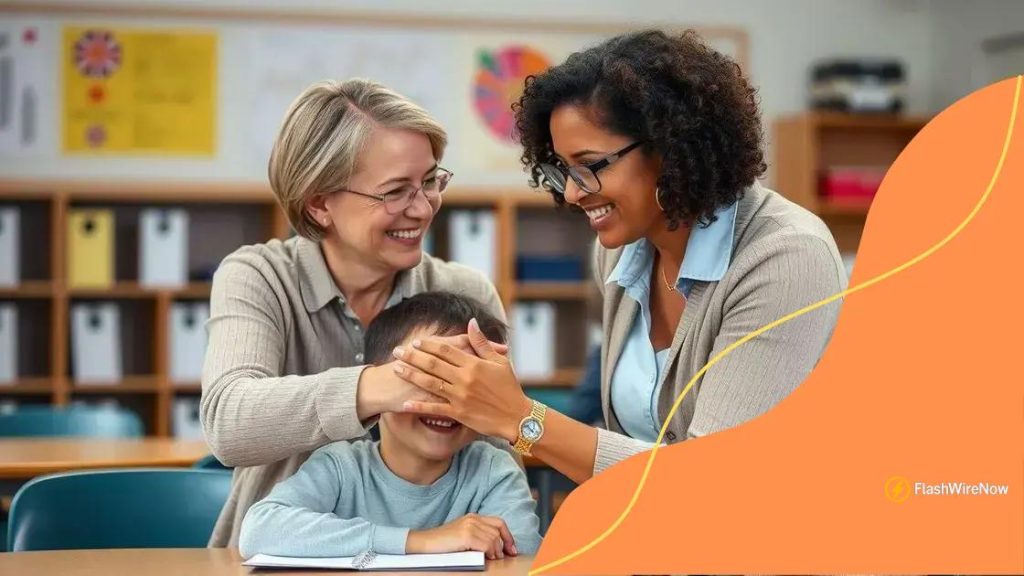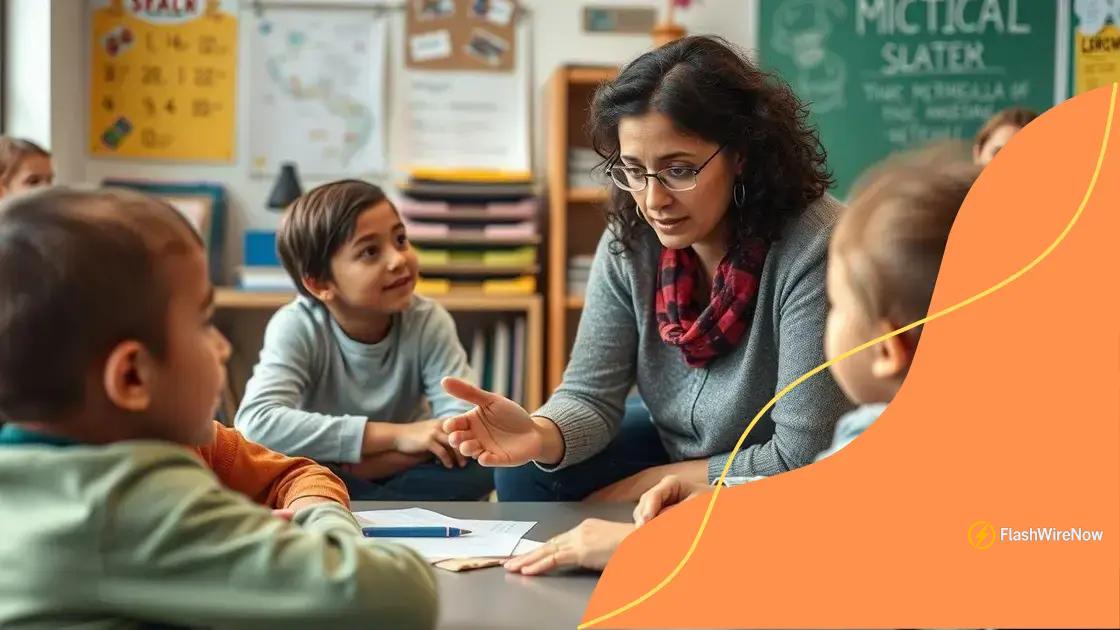Supporting students with social anxiety: practical strategies

Anúncios
Supporting students with social anxiety requires understanding their challenges, recognizing symptoms, implementing effective strategies, and creating a supportive environment to promote their academic and emotional well-being.
Supporting students with social anxiety can truly transform their educational experience. Have you noticed a student struggling in social settings? Let’s explore how we can help them feel supported and succeed in school.
Anúncios
Understanding social anxiety in students
Understanding social anxiety in students is crucial for educators and parents alike. Social anxiety can significantly impact a student’s ability to participate in class and interact with peers. Recognizing the signs early can help in providing support.
It’s important to note that social anxiety goes beyond typical shyness. Students with this condition often experience intense fear of social situations. This can lead to avoidance behaviors, making classroom participation challenging.
Key characteristics of social anxiety
Students may display various signs of social anxiety, including:
Anúncios
- Extreme nervousness in social interactions
- Fear of being judged or embarrassed
- Avoidance of group activities and speaking up in class
- Difficulty making friends
These behaviors may not always be apparent, making it essential for teachers and parents to observe their students closely and engage in open conversations.
In many cases, students are afraid of making mistakes in front of others. This fear can prevent them from trying new things. It affects their learning and social development. Understanding the underlying feelings can foster a supportive environment.
Impact on academic performance
Social anxiety doesn’t only affect social skills; it can also lead to academic struggles. Students may find it hard to focus during group work or may avoid asking questions due to fear. This can result in missed learning opportunities.
Effective communication is vital in helping students with social anxiety. By encouraging them to express their feelings, teachers can create a safe space. This not only helps in alleviating anxiety but also promotes confidence.
Additionally, fostering a classroom environment that celebrates diversity and inclusivity allows anxious students to feel more comfortable. When students see that everyone has unique strengths, it reduces pressure and anxiety.
Seeking further understanding
Encouraging students to talk about their feelings can lead to better understanding. Offering resources about social anxiety is also beneficial. Many students feel alone in their struggles, but knowing that support exists is powerful.
Ultimately, understanding social anxiety in students is the first step toward helping them thrive. By recognizing their struggles and providing the right support, we can empower them to overcome challenges.
Signs of social anxiety in the classroom
Recognizing the signs of social anxiety in the classroom is essential for teachers and caregivers. These signs often manifest in various ways, making it crucial to observe students closely. Noticing these behaviors early can lead to timely support.
Students with social anxiety may appear quiet and withdrawn. They often avoid eye contact and hesitate to participate in classroom discussions. This makes it difficult for them to engage with their peers and teachers. Many times, these behaviors are mistaken for shyness.
Common signs of social anxiety
Some common indicators include:
- Frequent fidgeting or nervous habits, such as biting nails
- Visible distress during group activities
- Avoidance of speaking in front of the class
- Looking down or away during interactions
These signs can vary from student to student. However, they point to deeper feelings of insecurity and fear of judgment. When teachers understand these signs, they can create a more inclusive classroom environment.
Another important aspect to consider is that these students may experience physical symptoms such as sweating, racing heart, or stomachaches. These can occur even in low-pressure situations, exacerbating their anxiety. Recognizing these physical signs is crucial for providing the right support.
Behavioral changes to watch for
Changes in behavior can also indicate social anxiety. For example, students who usually participate actively may suddenly withdraw. Others may frequently ask to leave the room due to anxiety related to social situations.
Building a trusting relationship with students can help them feel more at ease when expressing their feelings. Open discussions about anxiety can reduce stigmas and allow students to share their experiences without fear.
Overall, identifying the signs of social anxiety in the classroom can help create an environment where all students feel safe and supported. Early intervention is key to addressing their needs effectively.
Effective strategies to support anxious students

Implementing effective strategies to support anxious students is vital for their success in the classroom. These strategies can help create a more inclusive and understanding environment, allowing students to thrive academically and socially.
One of the key approaches is to encourage open communication. Inviting students to share their feelings fosters trust and helps them feel valued. This can be as simple as checking in with them regularly and asking how they feel.
Classroom modifications
Making certain adjustments in the classroom can greatly benefit anxious students. Consider the following:
- Providing extra time for assignments and tests
- Offering flexible seating arrangements
- Creating quiet areas in the classroom for breaks
- Using visual schedules to reduce uncertainty
These modifications help create a secure environment where students can express their anxiety without fear. Additionally, involving students in these discussions allows them to take ownership of their learning space.
Another effective strategy is teaching coping techniques. Educators can introduce activities such as deep breathing exercises or mindfulness practices. These methods empower students to manage their anxiety in real-time, promoting resilience.
Building peer support
Encouraging peer support is also essential. Establishing buddy systems can help students connect with classmates. These friendships can alleviate feelings of isolation. It also enables students to have someone to turn to during stressful moments.
Moreover, providing information about mental health can normalize discussions around anxiety. Including resources in the classroom or organizing workshops can create a supportive community around mental well-being. Students are more likely to reach out when they see that mental health is taken seriously.
Involving parents is another crucial aspect. Keeping an open line of communication with parents helps them understand their child’s needs. Regular updates and collaboration can help parents provide additional support at home, reinforcing what the student learns in school.
Integrating these effective strategies helps students feel more accepted and understood. Creating a compassionate and resourceful environment allows anxious students to build confidence and engage positively with their education.
Building a supportive school environment
Building a supportive school environment is essential to helping students with social anxiety feel safe and valued. A positive atmosphere encourages students to engage without fear of judgment. This promotes not only academic success but also emotional well-being.
One effective way to foster such an environment is through promoting inclusivity. Schools can implement programs that celebrate diversity and teach empathy among students. This can create a culture of acceptance, where every student feels they belong.
Creating a sense of community
To build this sense of community, schools can organize activities like:
- Team-building exercises that encourage collaboration
- Awareness days focused on mental health
- Peer mentorship programs that connect older and younger students
- Social events that welcome everyone, regardless of background
These activities help break down barriers between students. They provide opportunities for meaningful interactions, reducing feelings of isolation.
Another important aspect is training staff on mental health awareness. Educators should be equipped with the knowledge to recognize signs of social anxiety. Providing professional development workshops can help teachers become more supportive.
Encouraging open communication
Encouraging open lines of communication is key. Students should feel they can approach teachers and counselors without fear. This can be enhanced by having regular check-ins and providing anonymous feedback options.
Furthermore, having designated safe spaces within the school can provide refuge for students feeling overwhelmed. These spaces should be inviting and calm, allowing students to take a break when needed.
Additionally, parental involvement plays a crucial role in creating a supportive environment. Schools should liaise with parents to provide resources that help them understand and support their children’s needs at home.
Overall, implementing these practices allows for a supportive school environment that nurtures students’ mental health, leading to a more fulfilling educational experience.
When to seek professional help for students
Knowing when to seek professional help for students is crucial for their well-being. Many students face challenges that go beyond typical anxiety and require specialized support. Early intervention can make a significant difference in their emotional health.
It is important to watch for persistent signs of anxiety. If a student shows prolonged distress, such as excessive worry and avoidance of social situations, it may be time to reach out for professional support. These behaviors can interfere significantly with their daily functioning.
Signs that indicate a need for help
Some key signs that may indicate that a student requires professional assistance include:
- Inability to focus on academic tasks
- Withdrawal from social activities and friendships
- Physical symptoms like headaches or stomachaches with no medical cause
- Consistent low energy or fatigue
These symptoms can indicate that a student is struggling more than usual. It’s crucial to respond to these signals with compassion and understanding.
If self-help strategies or school resources do not alleviate the student’s anxiety, it may be beneficial to seek guidance from a mental health professional. Talking to a counselor or psychologist can provide students with tools to cope more effectively.
Steps to take
Families and educators should work together to ensure students receive the support they need. Here are steps to consider:
- Schedule an appointment with a mental health professional specializing in anxiety.
- Communicate openly with the student about their feelings and experiences.
- Collaborate with school staff to understand how the student behaves in a classroom setting.
- Remain patient and supportive throughout the process, as progress can take time.
Involving the student in discussions about seeking help can empower them. Understanding that they are not alone in their struggles and that support exists can be reassuring.
Ultimately, recognizing the signs and knowing when to seek professional help establishes a supportive framework that aids students in overcoming their challenges effectively. Early intervention can lead to positive outcomes, enhancing their overall school experience.
In summary, supporting students with social anxiety involves understanding their unique challenges, recognizing the signs, and implementing effective strategies. Building a supportive school environment is essential for encouraging students to engage fully with their peers and the learning process. It’s important to know when to seek professional help to ensure that students receive the care they need. By fostering open communication and a compassionate atmosphere, we can help students overcome their anxiety and thrive academically and socially. Together, we can create a school environment where all students feel valued and understood.
FAQ – Frequently Asked Questions About Supporting Students with Social Anxiety
What are the signs of social anxiety in students?
Signs of social anxiety may include excessive worry, avoidance of social interactions, physical symptoms like headaches, and withdrawal from activities.
How can teachers create a supportive environment for anxious students?
Teachers can foster a supportive environment by encouraging open communication, providing flexibility in classroom settings, and promoting inclusivity among students.
When should parents seek professional help for their child?
Parents should consider seeking professional help if their child shows persistent signs of anxiety that interfere with daily activities and social interactions.
What strategies can be implemented to help students cope with anxiety?
Effective strategies include teaching coping techniques like deep breathing, establishing routines, and providing access to mental health resources.





